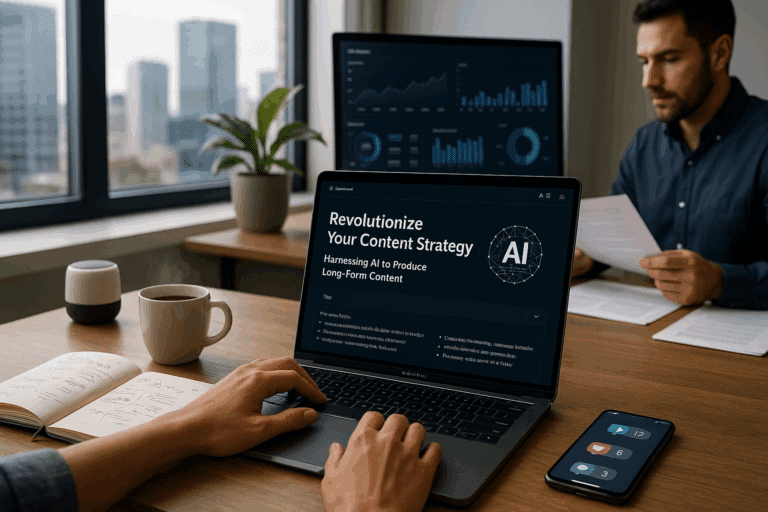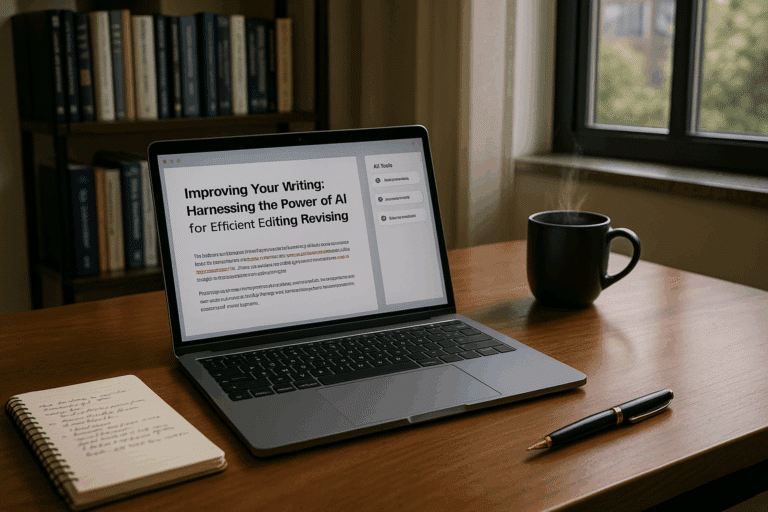In today’s technology-imbued age, Artificial Intelligence (AI) has undeniably become a game-changer, redefining limits, and pushing the boundaries of possibilities. While AI’s potential to generate content – be it text, images, or even videos – is truly mesmerizing, it also brings about ethical dilemmas that can’t be ignored. Unveiling the moral compass in this terrain has never been more vital. 👀🧭
In this article, we will delve into the ethically charged waters of AI-generated content. We’ll attempt to navigate the intricate maze of its ethical implications, drawing the line between innovation and infringement, creativity and authenticity, utility and abuse.🔄
Before we embark on this intellectual voyage, it’s important to understand that the power of AI is multi-dimensional. On one hand, it empowers businesses with predictive analytics, improves decision-making, and accelerates growth. 📈 On the other, it gives rise to new ethical quandaries, and brings into question the morality of using AI-generated content. Who owns the content? Where is the line between human creativity and AI-authored work? What about the issue of plagiarism and intellectual property rights? These are just the tip of the iceberg. ❄️
Of course, to navigate this labyrinth, we must first comprehend the technology that powers AI content generation. AI-based systems like GPT-3 or OpenAI are more than just lines of code. They’re powerful tools capable of creating human-like text, making it increasingly difficult to differentiate between man-made and machine-written content. 🧑💻=🤖?
However, while the technology might be awe-inspiring, it’s not exempt from ethical scrutiny. That’s why this article will take you on a journey through the ethics of AI-generated content. We’ll take a hard look at the ethical considerations, legal aspects, and societal implications of using AI in content creation. 🧐
In our quest to unravel these complexities, we’ll explore various perspectives, including those of AI developers, content creators, legal professionals, and consumers. We’ll assess the implications of AI-generated content on copyright laws, its impact on the creative industry, and the potential for misuse. ⚖️
We’ll also take a detour into the realm of deepfakes, one of the most controversial byproducts of AI content generation. We’ll discuss the ethical and legal challenges they present, the dangers of misinformation, and the need for stringent regulations. 🚫
Our ultimate goal is to foster a deeper understanding of the ethical landscape of AI-generated content. We hope to spark discussions, encourage critical thinking, and contribute to the formulation of robust ethical guidelines for AI content generation. 🧠⚡
So, fasten your seatbelts as we dive deep into the ethics of AI-generated content. This journey will not only enlighten you but will also equip you to make informed decisions in this ethically murky realm. Welcome to the fascinating world of AI ethics! 🚀
Understanding the Core of AI-Generated Content
Artificial intelligence (AI) has revolutionized the way we create and consume content. From personalized advertisements to news articles, AI is constantly generating content to meet specific user needs. However, as AI continues to evolve, it is essential to understand the ethical implications of AI-generated content.
AI algorithms are only as good as the data they learn from. In many cases, these datasets can be biased, resulting in AI-generated content that perpetuates harmful stereotypes or spreads misinformation. For instance, if an AI is trained on news articles from sources with a particular political bias, it will likely generate content that reflects that bias.
Consequently, the responsibility of curating an unbiased, factual and ethical AI-generated content lies with the developers and data scientists. They must ensure that the AI is trained on diverse datasets and that its output is continually monitored for potential ethical issues.
Navigating the Moral Landscape of AI-Generated Content
The ethical implications of AI-generated content are vast and complex. One of the major issues is the potential for AI to spread false information or “deepfakes”. Deepfakes are AI-generated videos or images that look convincingly real, but depict events or individuals in ways that never actually occurred. This poses a significant threat to our understanding of truth and reality.
Moreover, the use of AI in content creation also raises concerns about originality and authenticity. Since AI can create content based on existing data, it could potentially plagiarize or mimic human creativity without proper credit. There’s also the issue of accountability. If an AI creates defamatory or harmful content, who is held responsible?
Addressing these ethical issues requires a thorough understanding of AI technologies, rigorous ethical guidelines, and a commitment to transparency and accountability. To help illustrate these points, consider watching the following video: “The Ethics of AI: From Sci-Fi to Reality” by the TEDx Talks channel on YouTube. It provides valuable insights into the moral dilemmas posed by AI technologies.
Decoding Ethical Guidelines for AI-Generated Content
In response to these ethical concerns, several organizations have proposed guidelines to govern the use of AI in content creation. These guidelines typically emphasize principles such as transparency, fairness, and accountability.
Transparency refers to the need for AI systems to be open and understandable. This means that developers should clearly explain how their AI algorithms work and how they generate content. Fairness, on the other hand, requires that AI systems treat all individuals and groups equitably. This implies that AI should not favor certain groups or produce biased content. Lastly, accountability means that those who develop and use AI systems should be held responsible for their output.
Despite these guidelines, implementing ethical AI systems is a challenging task. It requires a multi-disciplinary approach that combines technological expertise with deep ethical understanding. To further explore this topic, you might find the following video insightful: “Ethical AI: Navigating the Challenges” by the Royal Society.
Comparing AI Ethics Across Different Regions
The ethical considerations of AI-generated content are not uniform across the globe. Different regions have varying approaches to AI ethics based on their cultural, societal and legal contexts.
| Region | Approach to AI Ethics |
|---|---|
| Europe | Emphasizes on human rights and privacy. The European Commission’s Ethics Guidelines for Trustworthy AI outlines seven key requirements, including transparency, diversity, and accountability. |
| United States | Focuses on innovation and economic competitiveness. The Office of Science and Technology Policy’s AI principles stress on public trust, public participation, scientific integrity, and disclosure. |
| China | Concentrates on social stability and national security. The Beijing AI Principles highlight harmony and friendliness, fairness and justice, and shared responsibility. |
These varying approaches reflect the complexities of AI ethics and the need for global cooperation. Understanding these different perspectives can help us develop more robust and universally acceptable AI ethics guidelines.
Embracing the Future of Ethical AI-Generated Content
As we move towards a future dominated by AI-generated content, it is essential to ensure that this technology is used ethically. This requires ongoing dialogue, rigorous testing, and continual reassessment of our ethical guidelines.
We must remember that AI is a tool, and like any tool, it can be used for good or ill. As developers, consumers, and citizens, we have a responsibility to ensure that AI serves us, and not the other way around.
As you navigate the fascinating world of AI-generated content, remember to question, learn, and engage in the ethical discourse. Together, we can ensure that AI is used in a way that benefits us all. Happy learning!

Conclusion
In conclusion, the importance of understanding the technical intricacies of Information Technology and Engineering cannot be overstated. As we have navigated through this comprehensive analysis, we have touched on many significant points that encapsulate the essence of these technical domains.
Let’s briefly revisit these key points. We discussed the fundamental principles of software engineering, exploring its inherent components like software design, coding, and testing. We delved into the complexities and methodologies of creating efficient software systems. This exploration offered an understanding of the importance of thorough planning and strategic execution in software development.
In the sphere of Information Technology, we unearthed the intricacies of systems analysis, network architecture, and IT governance. The spotlight was on the pivotal role of IT in driving modern businesses and how it intertwines with every facet of an organization, thus emphasizing its pervasive influence in today’s digital era.
A comprehension of these concepts and their applications is essential for everyone involved in these fields. The synergy of IT and engineering is an integral part of most of the technological advancements we see today. It’s the backbone of innovative solutions that are transforming our world, disrupting traditional norms, and paving the way for a future filled with limitless possibilities.
This exploration, while technical and specialized, is aimed at making these complex subjects more approachable. It’s crucial to remember that even though these topics can seem intimidating, they are not beyond understanding. Everyone can gain a solid grounding in these areas with the right approach and resources. Your journey might be challenging, but remember, every step you take brings you closer to your goal. Stay curious and keep exploring.😊
I encourage all of you to share your thoughts, experiences, and insights about these topics in the comments section below. Your inputs could provide valuable perspectives and contribute to a richer discussion. Let’s learn from each other and grow together. Feel free to share this article with others who might find it useful. 📚🌐
I also recommend further readings and research to deepen your understanding of these subjects. You can access a wealth of knowledge from credible sources like IBM, ACM, IEEE Xplore, and many more.
Thank you for investing your time in reading this article. I hope it has been informative and has sparked your interest in delving deeper into the fascinating realms of IT and engineering.
Remember, knowledge is power, and in the digital age, it’s your greatest asset. Keep learning, stay updated, and never stop exploring. The world of technology awaits you! 🚀🌠
References:
[1] IBM
[2] ACM
[3] IEEE Xplore



